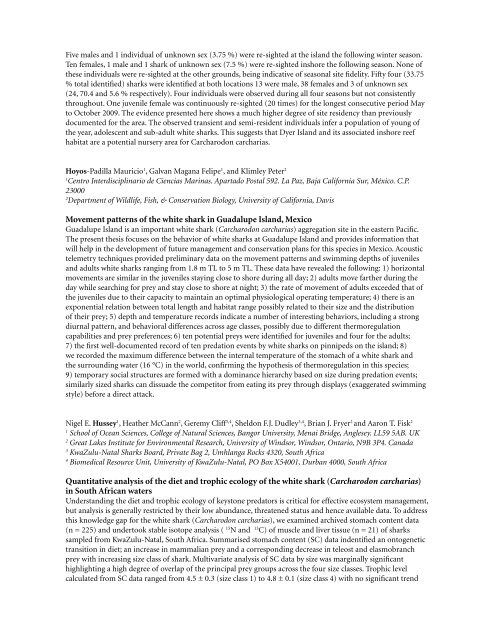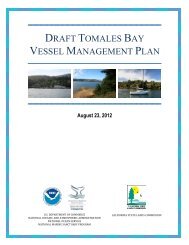Symposium program - Gulf of the Farallones National Marine ...
Symposium program - Gulf of the Farallones National Marine ...
Symposium program - Gulf of the Farallones National Marine ...
Create successful ePaper yourself
Turn your PDF publications into a flip-book with our unique Google optimized e-Paper software.
Five males and 1 individual <strong>of</strong> unknown sex (3.75 %) were re-sighted at <strong>the</strong> island <strong>the</strong> following winter season.<br />
Ten females, 1 male and 1 shark <strong>of</strong> unknown sex (7.5 %) were re-sighted inshore <strong>the</strong> following season. None <strong>of</strong><br />
<strong>the</strong>se individuals were re-sighted at <strong>the</strong> o<strong>the</strong>r grounds, being indicative <strong>of</strong> seasonal site fidelity. Fifty four (33.75<br />
% total identified) sharks were identified at both locations 13 were male, 38 females and 3 <strong>of</strong> unknown sex<br />
(24, 70.4 and 5.6 % respectively). Four individuals were observed during all four seasons but not consistently<br />
throughout. One juvenile female was continuously re-sighted (20 times) for <strong>the</strong> longest consecutive period May<br />
to October 2009. The evidence presented here shows a much higher degree <strong>of</strong> site residency than previously<br />
documented for <strong>the</strong> area. The observed transient and semi-resident individuals infer a population <strong>of</strong> young <strong>of</strong><br />
<strong>the</strong> year, adolescent and sub-adult white sharks. This suggests that Dyer Island and its associated inshore reef<br />
habitat are a potential nursery area for Carcharodon carcharias.<br />
Hoyos-Padilla Mauricio 1 , Galvan Magana Felipe 1 , and Klimley Peter 2<br />
1<br />
Centro Interdisciplinario de Ciencias Marinas. Apartado Postal 592. La Paz, Baja California Sur, México. C.P.<br />
23000<br />
2<br />
Department <strong>of</strong> Wildlife, Fish, & Conservation Biology, University <strong>of</strong> California, Davis<br />
Movement patterns <strong>of</strong> <strong>the</strong> white shark in Guadalupe Island, Mexico<br />
Guadalupe Island is an important white shark (Carcharodon carcharias) aggregation site in <strong>the</strong> eastern Pacific.<br />
The present <strong>the</strong>sis focuses on <strong>the</strong> behavior <strong>of</strong> white sharks at Guadalupe Island and provides information that<br />
will help in <strong>the</strong> development <strong>of</strong> future management and conservation plans for this species in Mexico. Acoustic<br />
telemetry techniques provided preliminary data on <strong>the</strong> movement patterns and swimming depths <strong>of</strong> juveniles<br />
and adults white sharks ranging from 1.8 m TL to 5 m TL. These data have revealed <strong>the</strong> following: 1) horizontal<br />
movements are similar in <strong>the</strong> juveniles staying close to shore during all day; 2) adults move far<strong>the</strong>r during <strong>the</strong><br />
day while searching for prey and stay close to shore at night; 3) <strong>the</strong> rate <strong>of</strong> movement <strong>of</strong> adults exceeded that <strong>of</strong><br />
<strong>the</strong> juveniles due to <strong>the</strong>ir capacity to maintain an optimal physiological operating temperature; 4) <strong>the</strong>re is an<br />
exponential relation between total length and habitat range possibly related to <strong>the</strong>ir size and <strong>the</strong> distribution<br />
<strong>of</strong> <strong>the</strong>ir prey; 5) depth and temperature records indicate a number <strong>of</strong> interesting behaviors, including a strong<br />
diurnal pattern, and behavioral differences across age classes, possibly due to different <strong>the</strong>rmoregulation<br />
capabilities and prey preferences; 6) ten potential preys were identified for juveniles and four for <strong>the</strong> adults;<br />
7) <strong>the</strong> first well-documented record <strong>of</strong> ten predation events by white sharks on pinnipeds on <strong>the</strong> island; 8)<br />
we recorded <strong>the</strong> maximum difference between <strong>the</strong> internal temperature <strong>of</strong> <strong>the</strong> stomach <strong>of</strong> a white shark and<br />
<strong>the</strong> surrounding water (16 °C) in <strong>the</strong> world, confirming <strong>the</strong> hypo<strong>the</strong>sis <strong>of</strong> <strong>the</strong>rmoregulation in this species;<br />
9) temporary social structures are formed with a dominance hierarchy based on size during predation events;<br />
similarly sized sharks can dissuade <strong>the</strong> competitor from eating its prey through displays (exaggerated swimming<br />
style) before a direct attack.<br />
Nigel E. Hussey 1 , Hea<strong>the</strong>r McCann 2 , Geremy Cliff 3,4 , Sheldon F.J. Dudley 3,4 , Brian J. Fryer 2 and Aaron T. Fisk 2<br />
1<br />
School <strong>of</strong> Ocean Sciences, College <strong>of</strong> Natural Sciences, Bangor University, Menai Bridge, Anglesey. LL59 5AB. UK<br />
2<br />
Great Lakes Institute for Environmental Research, University <strong>of</strong> Windsor, Windsor, Ontario, N9B 3P4. Canada<br />
3<br />
KwaZulu-Natal Sharks Board, Private Bag 2, Umhlanga Rocks 4320, South Africa<br />
4<br />
Biomedical Resource Unit, University <strong>of</strong> KwaZulu-Natal, PO Box X54001, Durban 4000, South Africa<br />
Quantitative analysis <strong>of</strong> <strong>the</strong> diet and trophic ecology <strong>of</strong> <strong>the</strong> white shark (Carcharodon carcharias)<br />
in South African waters<br />
Understanding <strong>the</strong> diet and trophic ecology <strong>of</strong> keystone predators is critical for effective ecosystem management,<br />
but analysis is generally restricted by <strong>the</strong>ir low abundance, threatened status and hence available data. To address<br />
this knowledge gap for <strong>the</strong> white shark (Carcharodon carcharias), we examined archived stomach content data<br />
(n = 225) and undertook stable isotope analysis (δ 15 N and δ 13 C) <strong>of</strong> muscle and liver tissue (n = 21) <strong>of</strong> sharks<br />
sampled from KwaZulu-Natal, South Africa. Summarised stomach content (SC) data indentified an ontogenetic<br />
transition in diet; an increase in mammalian prey and a corresponding decrease in teleost and elasmobranch<br />
prey with increasing size class <strong>of</strong> shark. Multivariate analysis <strong>of</strong> SC data by size was marginally significant<br />
highlighting a high degree <strong>of</strong> overlap <strong>of</strong> <strong>the</strong> principal prey groups across <strong>the</strong> four size classes. Trophic level<br />
calculated from SC data ranged from 4.5 ± 0.3 (size class 1) to 4.8 ± 0.1 (size class 4) with no significant trend







